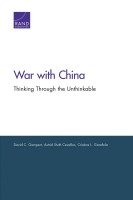| 来源类型 | Research Reports
|
| 规范类型 | 报告
|
| DOI | https://doi.org/10.7249/RR1140
|
| ISBN | 9780833091550
|
| 来源ID | RR-1140-A
|
| War with China: Thinking Through the Unthinkable |
| David C. Gompert; Astrid Stuth Cevallos; Cristina L. Garafola
|
| 发表日期 | 2016
|
| 出版年 | 2016
|
| 页码 | 116
|
| 语种 | 英语
|
| 结论 |
Unless Both U.S. and Chinese Political Leaders Decline to Carry Out Counterforce Strategies, the Ability of Either State to Control the Ensuing Conflict Would Be Greatly Impaired- Both sides would suffer large military losses in a severe conflict. In 2015, U.S. losses could be a relatively small fraction of forces committed, but still significant; Chinese losses could be much heavier than U.S. losses and a substantial fraction of forces committed.
- This gap in losses will shrink as Chinese A2AD improves. By 2025, U.S. losses could range from significant to heavy; Chinese losses, while still very heavy, could be somewhat less than in 2015, owing to increased degradation of U.S. strike capabilities.
- China's A2AD will make it increasingly difficult for the United States to gain military-operational dominance and victory, even in a long war.
Conflict Could Be Decided by Domestic Political, International, and Economic Factors, All of Which Would Favor the United States in a Long, Severe War- Although a war would harm both economies, damage to China's would be far worse.
- Because much of the Western Pacific would become a war zone, China's trade with the region and the rest of the world would decline substantially.
- China's loss of seaborne energy supplies would be especially damaging.
- A long conflict could expose China to internal political divisions.
- Japan's increased military activity in the region could have a considerable influence on military operations.
|
| 摘要 |
- U.S. and Chinese political leaders alike should have military options other than immediate strikes to destroy opposing forces.
- U.S. leaders should have the means to confer with Chinese leaders and contain a conflict before it gets out of hand.
- The United States should guard against automaticity in implementing immediate attacks on Chinese A2AD and have plans and means to prevent hostilities from becoming severe. Establishing "fail safe" arrangements will guarantee definitive, informed political approval for military operations.
- The United States should reduce the effect of Chinese A2AD by investing in more-survivable force platforms (e.g., submarines) and in counter-A2AD (e.g., theater missiles).
- The United States should conduct contingency planning with key allies, especially Japan.
- The United States should ensure that the Chinese are specifically aware of the potential for catastrophic results even if a war is not lost militarily.
- The United States should improve its ability to sustain intense military operations.
- U.S. leaders should develop options to deny China access to war-critical commodities and technologies in the event of war.
- The United States should undertake measures to mitigate the interruption of critical products from China.
- Additionally, the U.S. Army should invest in land-based A2AD capabilities, encourage and enable East Asian partners to mount strong defense, improve interoperability with partners (especially Japan), and contribute to the expansion and deepening of Sino-U.S. military-to-military understanding and cooperation to reduce dangers of misperception and miscalculation.
|
| 主题 | China
; International Diplomacy
; Japan
; Threat Assessment
; United States
; Warfare and Military Operations
|
| URL | https://www.rand.org/pubs/research_reports/RR1140.html
|
| 来源智库 | RAND Corporation (United States)
|
| 引用统计 |
|
| 资源类型 | 智库出版物
|
| 条目标识符 | http://119.78.100.153/handle/2XGU8XDN/108432
|
推荐引用方式
GB/T 7714 |
David C. Gompert,Astrid Stuth Cevallos,Cristina L. Garafola. War with China: Thinking Through the Unthinkable. 2016.
|
|
文件名:
|
x1535055275362.jpg
|
|
格式:
|
JPEG
|

|
文件名:
|
RAND_RR1140.pdf
|
|
格式:
|
Adobe PDF
|
除非特别说明,本系统中所有内容都受版权保护,并保留所有权利。